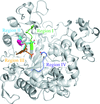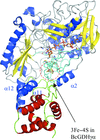issue contents
September 2019 issue

Cover illustration: Apo YfeA, a polyspecific cluster A-I substrate-binding protein from Yersinia pestis [Radka et al. (2019), Acta Cryst. D75, 831-840].
CCP-EM
Open  access
access
 access
accessA workflow to combine cryo-EM data collected at different magnification.
research papers
The induced-fit motion of an active-site loop (residues 706–710) including the catalytic acid/base residue Glu706 in pullulanase from Klebsiella pneumoniae (KPP) belonging to glycoside hydrolase family 13 subfamily 13 was examined by mutational and structural analysis. Analysis of the structure and activity of recombinant pullulanase from K. pneumoniae ATCC 9621 (rKPP) and its G680L mutant indicated that the side chain of residue 680 is important for the conformational change of the loop 706–710 in the ligand-free form, resulting in the altered binding affinity of the substrate.
A study of laccase inhibition by chloride and fluoride anions is presented. Single-crystal serial crystallography at subatomic resolution is applied to a study of the enzymatic reaction mechanism.
PDB references: structures of native laccase from X-ray data series with increasing absorbed radiation doses, 6rgh; 6rgp; 6rhh; 6rhi; 6rho; 6rhp; structures of laccase complexed with chloride anion from X-ray data series with increasing absorbed radiation doses, 6rhr; 6rhu; 6rhx; 6ri0; 6ri2; structures of laccase complexed with fluoride anion from X-ray data series with increasing absorbed radiation doses, 6ri4; 6ri6; 6ri8; 6rii; 6rik; 6ril
Open  access
access
 access
accessBy installing calcium-ligand triads found in olfactomedin sequences from invertebrates, insight was gained into calcium-binding features across the protein family and new surface conformations were observed that may be relevant to elusive protein–protein interactions.
The crystal structure of the N-terminal domain of the major virulence factor BB0323 from the Lyme disease agent Borrelia burgdorferi, which is essential for membrane integrity, cell fission and infectivity, is reported.
Open  access
access
 access
accessA cluster A-I substrate-binding protein reveals conformational changes, including an asymmetric rigid-body rotation of the flexible lobe, the reordering of a mobile helix and a spring-hammer mechanism.
Open  access
access
 access
accessThe X-ray structure of the catalytic subunit of Burkholderia cepacia FAD glucose dehydrogenase complexed with a hitchhiker protein was determined as a representative molecule of direct electron transfer-type FAD-dependent dehydrogenase complexes. The 3Fe–4S cluster is present at the surface of the catalytic subunit and serves in the intramolecular and intermolecular electron transfer from FAD to the electron-transfer subunit.
Open  access
access
 access
accessA higher dimensional superspace description accounts for an unexpected supercell refinement result.


 journal menu
journal menu
























